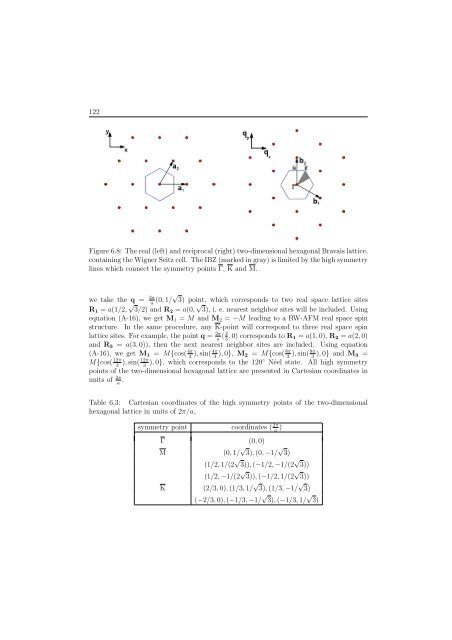Ab initio investigations of magnetic properties of ultrathin transition ...
Ab initio investigations of magnetic properties of ultrathin transition ...
Ab initio investigations of magnetic properties of ultrathin transition ...
Create successful ePaper yourself
Turn your PDF publications into a flip-book with our unique Google optimized e-Paper software.
122<br />
Figure 6.8: The real (left) and reciprocal (right) two-dimensional hexagonal Bravais lattice,<br />
containing the Wigner Seitz cell. The IBZ (marked in gray) is limited by the high symmetry<br />
lines which connect the symmetry points Γ, K and M.<br />
we take the q = 2π<br />
a (0, 1/√ 3) point, which corresponds to two real space lattice sites<br />
R1 = a(1/2, √ 3/2) and R2 = a(0, √ 3), i. e. nearest neighbor sites will be included. Using<br />
equation (A-16), we get M1 = M and M2 = −M leading to a RW-AFM real space spin<br />
structure. In the same procedure, any K-point will correspond to three real space spin<br />
lattice sites. For example, the point q = 2π 2 ( a 3 , 0) corresponds to R1 = a(1, 0), R2 = a(2, 0)<br />
and R3 = a(3, 0)), then the next nearest neighbor sites are included. Using equation<br />
(A-16), we get M1 = M{cos( 4π 4π ), sin( 3 3 ), 0}, M2 = M{cos( 8π 8π ), sin( 3 3 ), 0} and M3 =<br />
M{cos( 12π<br />
12π ), sin( 3 3 ), 0}, which corresponds to the 120◦ Néel state. All high symmetry<br />
points <strong>of</strong> the two-dimensional hexagonal lattice are presented in Cartesian coordinates in<br />
units <strong>of</strong> 2π<br />
a .<br />
Table 6.3: Cartesian coordinates <strong>of</strong> the high symmetry points <strong>of</strong> the two-dimensional<br />
hexagonal lattice in units <strong>of</strong> 2π/a.<br />
symmetry point coordinates ( 2π<br />
a )<br />
Γ (0, 0)<br />
M (0, 1/ √ 3), (0, −1/ √ 3)<br />
(1/2, 1/(2 √ 3)), (−1/2, −1/(2 √ 3))<br />
(1/2, −1/(2 √ 3)), (−1/2, 1/(2 √ 3))<br />
K (2/3, 0), (1/3, 1/ √ 3), (1/3, −1/ √ 3)<br />
(−2/3, 0), (−1/3, −1/ √ 3), (−1/3, 1/ √ 3)

















